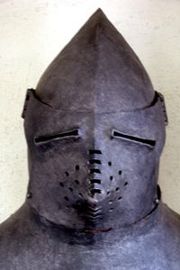
Hounskull
Encyclopedia

Steel
Steel is an alloy that consists mostly of iron and has a carbon content between 0.2% and 2.1% by weight, depending on the grade. Carbon is the most common alloying material for iron, but various other alloying elements are used, such as manganese, chromium, vanadium, and tungsten...
helmet
Helmet
A helmet is a form of protective gear worn on the head to protect it from injuries.Ceremonial or symbolic helmets without protective function are sometimes used. The oldest known use of helmets was by Assyrian soldiers in 900BC, who wore thick leather or bronze helmets to protect the head from...
worn in Europe
Europe
Europe is, by convention, one of the world's seven continents. Comprising the westernmost peninsula of Eurasia, Europe is generally 'divided' from Asia to its east by the watershed divides of the Ural and Caucasus Mountains, the Ural River, the Caspian and Black Seas, and the waterways connecting...
in the Middle Ages
Middle Ages
The Middle Ages is a periodization of European history from the 5th century to the 15th century. The Middle Ages follows the fall of the Western Roman Empire in 476 and precedes the Early Modern Era. It is the middle period of a three-period division of Western history: Classic, Medieval and Modern...
, almost invariably by knights and other mounted men-at-arms, from the middle of the 14th century until approximately 1420. It offered extensive protection for the wearer's face at the cost of some visibility, but its distinctive visor could be raised or lowered at will.
Form
The hounskull was a form of bascinetBascinet
The bascinet was a Medieval European open-faced military helmet, typically fitted with an aventail and hinged visor. The term is also written as bassinet or basinet.-Early versions:...
with a visor
Visor
A visor is a surface that protects the eyes, such as shading them from the sun or other bright light or protecting them from objects....
covering the entire face. It is the visor which gives the helmet its name, as this resembles the face of a dog ("hound" or, in German, "Hund"), with a protruding muzzle in order to better protect the face from blows and to grant greater ventilation (which was largely afforded the wearer, when the visor was down, through holes in the "muzzle," such holes being either on the right side of the "muzzle" with additional holes near the mouth, or on both sides).
The visor swung up to uncover the wearer's face when he was not in combat, to grant him better visibility and unrestricted ventilation. This was accomplished in one of two ways. The most common form of visor in Central Europe was held on by a single hinge fastened to the center of the top of the visor, called a Klappviser. The other version had two pivot bolts on either side of the visor attaching it to the bascinet at the temples, and this was the most common form found in Southern, Western and Northwestern Europe.
The wearer peered through two vision slots when the visor was lowered. The vision slots were either relatively flush with the visor, as was the custom in Western Europe, or elevated on mounts on the visor, as was commonly the case in Central Europe.
As with all bascinets, the helmet generally had attachment points for armour to protect the neck and upper body, initially an aventail
Aventail
An aventail or camail is a flexible curtain of mail on a helmet that extends to cover the neck and shoulders. The mail could be attached to the helm by threading a leather cord through brass rings at the edge of the helm. Aventails were most commonly seen on bascinets in the 14th century and...
of mail
Mail
Mail, or post, is a system for transporting letters and other tangible objects: written documents, typically enclosed in envelopes, and also small packages are delivered to destinations around the world. Anything sent through the postal system is called mail or post.In principle, a postal service...
and, later, plate armour. The chain aventail could have a decorative cloth cover.
Usage
The addition of the visor to the bascinet came about due to the ongoing need to protect the face of the man-at-arms. The great helmGreat helm
The great helm or heaume, also called pot helm, bucket helm and barrel helm, of the High Middle Ages arose in the late twelfth century in the context of the crusades and remained in use until the fourteenth century...
had been increasingly abandoned for the bascinet in the first half of the fourteenth century, but the bascinet did not protect the face, and this led to increasing casualties to the wearer, particularly in the Hundred Years War, due to the dominance of the longbow
Longbow
A longbow is a type of bow that is tall ; this will allow its user a fairly long draw, at least to the jaw....
as a weapon. Various expedients were adopted, eventually culminating in a full hounskull helmet with its visor soon after 1350.
This helmet became so ubiquitous that it was virtually the symbol of the knight during the second half of the fourteenth century, sometimes illustrated as worn by all knightly combatants in period illustrations. The hounskull lingered in use for some time after that, although it was decidedly out of fashion after the second decade of the fifteenth century. The last time it is depicted in widespread use in period art is by the "Armagnac" mercenaries who invaded Switzerland in 1444
Battle of St. Jakob an der Birs
The Battle of St. Jakob an der Birs was fought between the Old Swiss Confederacy and French mercenaries , on the banks of the river Birs...
.

